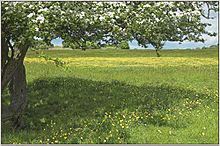Minchinhampton Common facts for kids
| Site of Special Scientific Interest | |

Minchinhampton Common flowering
|
|
| Area of Search | Gloucestershire |
|---|---|
| Coordinates | 51°42′29″N 2°12′38″W / 51.707997°N 2.210522°W |
| Interest | Biological/Geological |
| Area | 182.7 hectare |
| Notification | 1972 |
Minchinhampton Common is a very special place in Gloucestershire, England. It covers about 183 hectares, which is like 450 football fields! This area is protected as a Site of Special Scientific Interest (SSSI) because of its amazing plants, animals, and rocks. It was first recognized as special in 1972.
The National Trust looks after Minchinhampton Common. It is one of the biggest open grasslands in the Cotswolds area. The common sits on top of old Jurassic limestone rocks. It has a flat top and steep sides that drop down into the valleys of Nailsworth and Frome. Nearby areas like Iron Mills and Littleworth Commons are also part of this special site. A nature reserve called Neu-Lindsey is right next to it.
Minchinhampton Common is important for both its geology (rocks and fossils) and its biology (living things). There are old quarries where scientists find fossils. The grassland here is very natural and full of different kinds of plants. You can also find the ancient Longstone of Minchinhampton, a big stone that some people believe is a burial site from long ago.
Contents
Discovering Ancient Rocks and Fossils
The old quarries at Minchinhampton Common are very important for studying rocks. They show us rocks from the Middle Jurassic period, which was millions of years ago! These rocks are full of fossils from sea creatures.
What Fossils Can You Find?
Scientists have found many types of ancient sea life here. These include different kinds of bivalves (like clams) and gastropods (like snails). You can also find fossils of limpets, thick-shelled sea snails, and even coral. Some fossils of crustaceans (like crabs) and reptiles have also been discovered. These fossils help scientists learn about what the Earth was like a very long time ago.
Exploring the Amazing Wildlife
Plants of the Common
The flat top of the common has short grass because cows graze there. On the steeper slopes, the plants grow taller. You can see different grasses like upright brome, tor-grass, and quaking grass.
Many beautiful flowering plants grow here too. Look for common rock-rose, harebell, and field scabious. The common is also home to many types of orchids, including the pretty bee orchid, the sweet-smelling fragrant orchid, and the rare frog orchid.
In some wet areas, you'll find plants that like marshy ground. There are also bushes like hawthorn, bramble, and dog rose. You might even spot some juniper bushes and small areas of woodland around the edges.
Animals and Insects of the Common
Minchinhampton Common is a great place for insects, especially butterflies. You might see colorful butterflies like the chalkhill blue, small blue, marsh fritillary, and the Duke of Burgundy fritillary. Moths like the cistus forester and juniper carpet also live here.
A very rare animal, the greater horseshoe bat, has been found hibernating (sleeping through winter) in the old stone mines on the Nailsworth side of the common.
How People Use the Common
Minchinhampton Common is used for many things. There is a golf course on part of the common. Farmers also let their cattle graze on the grass during the warmer months. A person called a "hayward" manages this grazing. Because cows roam freely, there's a speed limit of 40 miles per hour for cars in the area to keep everyone safe. During World War II, a US military hospital was even set up on part of the common.

